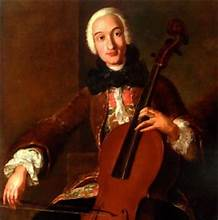Two Lisbon Chamber Concerts Survey the Classical Era
I recently enjoyed two recent concerts by Lisbon-area chamber orchestras, i.e. the Orquestra Metropolitana de Lisboa (OML) and the Orquestra de Câmara de Cascais e Oeiras (OCCO). The repertoire of these concerts roughly spanned Beethoven’s lifespan, (the classical to early romantic eras), and provided an entertaining overview of how classical music developed between 1770 and 1830.
OML’s concert in the large concert hall in Belém began with two early Classical works of Luigi Boccherini (1743-1805). The 26th symphony (1788) was a peppy Italianate piece without much depth. His ninth cello concerto (ca 1770) showcased the excellent young Austrian cellist Julia Hagen. Boccherini was a cello virtuoso who expanded cello technique, especially extending the instrument’s range to very high notes, often in the range of the violin. This concerto featured that extended technique. It’s a bit old-fashioned compared to the contemporaneous mature concerti of Mozart, since the cello played exclusively with a small string group, with the full orchestra only coming in separately for tutti sections that were clearly demarcated from the cello solos. This compartmentalized design was common in older Baroque music.
OCCO began its concert with an unmemorable 1785 symphony by Carl Friedrich Abel (1723-1787), a student of JS Bach and a London buddy of Bach’s composer-son Johann Christian Bach. The symphony’s lack of imagination was clear when compared to the orchestra’s fine rendition of the much earlier Haydn Symphony 59 in A major from the 1760’s. Here Haydn still shows Baroque tendences, eg an emphasis on the first violins, and the bassoon and bass doubling the cellos. But the symphony already shows Haydn’s flair for experimentation and drama, eg the tense opening and the slow movement that is strings-only until the very last moments, creating a sense of orchestration surprise. The acoustics in São Jose do Estoril’s Auditorio Sra. Boa Nova were outstanding, and the OCCO sounded great and well balanced there.
By the early Romantic era, orchestration had become much more complex, and both concerts demonstrated this. The OCCO featured the first clarinet concerto of Carl Maria von Weber, composed in 1811. This felt like a different world from the Boccherini cello concerto composed 40 years earlier. The orchestration was varied, and truly partnered the fine 16-year-old (!) soloist João Pedro Sousa. I especially enjoyed the very creative opening of the slow movement, featuring the solo clarinet tune accompanied by a horn trio (horns were a bit ragged here), and the exciting rondo finale. By the time of this concerto Beethoven had revolutionized how a concerto should be written, now as a true dialogue between orchestra and soloist, and this Weber concerto really demonstrated that progress.
The OML’s choice of an early romantic piece was Mendelssohn’s Symphony No.
4 (“Italian”, 1833). In many ways, this “romantic” symphony still feels like a
late classical work, with rapid violin passagework as the main driving force. However,
compared to the works of Haydn and Boccherini, the symphony now has more varied
and dramatic harmony, and more equal balancing of winds and strings. This OML
performance was peppy and fun, but lacked that last bit of string virtuosity to
take it to the top level. Overall, these concerts were excellent surveys of how
music progressed during Beethoven’s lifetime, well played by two fine local
groups.

Comments
Post a Comment